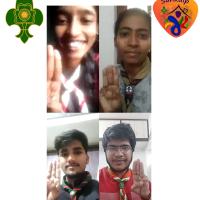
Project - Sankalp Group (A) - "Reachout" BS&G D.H.Q. Jodhpur, Rajasthan, India
Project SANKALP
[A] Health and Well-being
Challenge 1 – #Reachout
I am Rover Mate Jaishwar Prajapat from Bharat Scouts and Guides Divisional Headquarter Jodhpur, Rajasthan State. India.
7th April 2020
It's my pleasure that am very glad to Call more than 5 of my friends & well-wishers to inform
them about Covid-19, various modes of transmission and we discussed. . how to take
preventive measures to combat its spread and the steps taken by our
Government of INDIA to contain the pandemic likewise
21daylockdown and it's extended health benefits
and urged all of them to stayathome and encourage them to call 5 of their
contacts and do the same and keep the chain going on.. .
I told these things to all my friends during the call -
1. Stay in your house. Stay healthy - Stay safe.
2. Put a mask or handkerchief on the mouth.
3. Only one person should leave the house when there is a need. Wash food and water thoroughly with water and use it.
4. Do not shake hands with anyone, keep a distance of at least one meter.
5. Wash hands repeatedly with soap during the day and do not touch unnecessary mouth, nose, eyes with hands.
6. Cough, headache, bad headache, sneezing, high fever with cough in the throat, contact the doctor immediately.
7. Drink lukewarm water during the day, steam the water, add salt and turmeric to the hot water and gargle it, drink turmeric powder in the milk.
I gave all the above instructions to my friends and instructed them to call their five friends ahead and give them further instructions.
A special thanks to everyone who have been joined together in the corona awarness talk ..Hope the chain will be continuing with awarness Drive of Covid 19.
Thanks to Bharat Scouts and Guides India for arranging such an effective project all over India for Members of Bharat Scouts and Guides India.
I have uploaded this challenge on Social Site Facebook as a #Goodturn using hastags #stayathome #21daylockdown #fightcovid19 #bsgindia #goodturn
#sankalpbyscoutguide sankalp
Aerosol transmission
In order for the virus to be spread without being coughed or sneezed in large drops of mucus, it has to somehow be able to suspend in the air for long enough to infect passersby. And that’s another complicating factor in figuring out transmission: People emit virus particles in a range of sizes, and some are small enough to be considered aerosols, or fine particles that can stay suspended in the air for hours and can travel with air currents across tens of feet. A study published March 17 in the New England Journal of Medicine found that virus particles that were aerosolized could remain viable for up to 3 hours.
What's not clear from this data is whether the virus is commonly transmitted via aerosols, or how long the virus remains infectious in aerosols in real-world settings. In that study, researchers used an extremely high concentration of virus particles, which may not reflect those shed by people with the disease.
"To my knowledge, there is no definitive evidence of transmission where aerosol was the only possible route," Santarpia told Live Science. (For instance, even someone who's not sneezing may emit respiratory droplets when talking, because people may spit when talking, and those droplets could be deposited on surfaces.)
Contact transmission
There's one other route that's thought to play a role in the spread of COVID-19: contact transmission. In that situation, viral particles emitted from the respiratory tract of an infected individual land on a surface. Then, another person touches that object, then touches their nose, mouth or eyes. The virus then sneaks into the body via the mucous membranes, infecting the second person.
So far, no one knows how common this mode of transmission is, but it does seem to be possible. One study found that SARS-CoV-2 could remain viable on surfacessuch as cardboard for up to 24 hours, and on plastic and steel for 2 to 3 days.
Santarpia has studied viral surface contamination in the context of patients hospitalized with COVID-19 at the University of Nebraska Medical Center. In that study, which was published March 26 on the preprint database medRxiv, Santarpia and his colleagues found viral contamination in air samples, on surfaces such as toilets, and on frequently touched surfaces. Also on March 26, the CDC published a report on the coronavirus-stricken Diamond Princess cruise ship. An investigative team found traces of RNA from SARS-CoV-2 on surfaces throughout the cruise ship, in the cabins of both symptomatic and asymptomatic infected passengers, up to 17 days later — though no evidence suggests this viral RNA was still infectious. (SARS-CoV-2 is an RNA virus, meaning its main genetic material is RNA, not DNA.)














